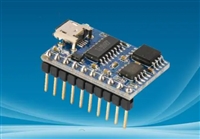
EPM570F256I5N The recognition rate of speech chip refers to the ability of speech recognition system to correctly recognize the input speech content. There are many factors that affect the recognition rate of speech chip, including speech quality, speech environment, speech model, speech data, etc.
1. Voice quality: Voice quality refers to the clarity and accuracy of voice signals. Poor voice quality will cause the voice chip to be unable to correctly recognize voice content. Common factors affecting speech quality include noise, echo, distortion, etc. Noise will interfere with the transmission of speech signals, making it difficult for speech chips to recognize accurately. Echo refers to the signal generated by the reflection of speech signals from obstacles in the transmission process, which will lead to overlapping of speech signals and affect the accuracy of speech recognition. Distortion means that the speech signal is disturbed or deformed in the transmission process, resulting in signal distortion, which makes the speech chip unable to recognize correctly.
2. Voice environment: Voice environment refers to the physical environment conditions in the process of speech recognition. Different speech environments have different effects on the recognition rate of speech chips. Common speech environment factors include noise, echo, interference, etc. High noise environment will interfere with the transmission of voice signals, resulting in the voice chip can not recognize correctly. Echo will make speech signals overlap and affect the accuracy of speech recognition. Other interferences, such as phone ringing and background music, will also interfere with the accuracy of speech recognition.
3. Speech model: Speech model is a model used by speech chip to recognize speech content. The accuracy and coverage of speech models will directly affect the recognition rate. The accuracy of speech model depends on the training data and algorithm of the model. The more and more accurate the training data of the model, the higher the recognition rate of the model. The coverage of a speech model refers to the range of speech content that the model can recognize. If the model only trains for a specific field or a specific population, the recognition rate may decrease in speech recognition in other fields or populations.
4. Voice data: Voice data is a data set used to train and optimize voice models. The quality and diversity of speech data have an important impact on the recognition rate of speech chips. High quality speech data sets can provide more accurate model training, thus improving the recognition rate. At the same time, the diversity of voice data is also very important, because voice chips need to be able to recognize the voice of different people, different accents and dialects, and different speech speeds and tones. If the speech data set lacks diversity, the speech chip may not be able to accurately recognize various speech contents in practical applications.
5. Algorithm and technology of speech chip: The algorithm and technology of speech chip is one of the key factors that determine the recognition rate. Different algorithms and technologies can be used in speech signal preprocessing, feature extraction, model training and recognition. Excellent algorithms and technologies can improve the recognition rate of speech chips. Common speech chip algorithms and technologies include speech enhancement algorithm, feature extraction algorithm, model training algorithm (such as deep learning algorithm), etc.
In a word, the recognition rate of speech chip is affected by many factors, including speech quality, speech environment, speech model, speech data, algorithm and technology. Optimizing these factors can improve the recognition rate of speech chip and make it more accurate and reliable in practical applications.

